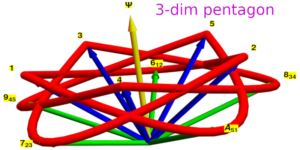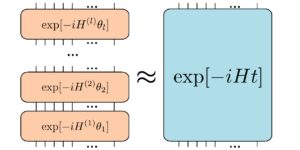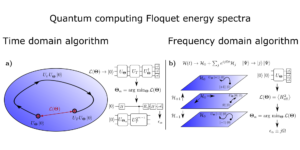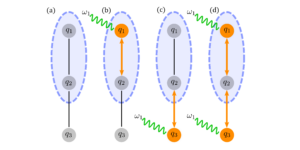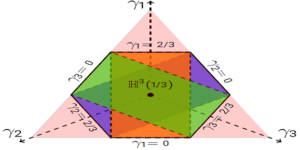1Department of Physics and Institute for Quantum Information and Matter, California Institute of Technology, Pasadena, CA 91125 USA
2IBM Quantum, IBM T.J. Watson Research Center, Yorktown Heights, NY 10598 USA
3IBM Almaden Research Center, San Jose, CA 95120 USA
Find this paper interesting or want to discuss? Scite or leave a comment on SciRate.
Abstract
Recently, a class of fractal surface codes (FSCs), has been constructed on fractal lattices with Hausdorff dimension $2+epsilon$, which admits a fault-tolerant non-Clifford CCZ gate [1]. We investigate the performance of such FSCs as fault-tolerant quantum memories. We prove that there exist decoding strategies with non-zero thresholds for bit-flip and phase-flip errors in the FSCs with Hausdorff dimension $2+epsilon$. For the bit-flip errors, we adapt the sweep decoder, developed for string-like syndromes in the regular 3D surface code, to the FSCs by designing suitable modifications on the boundaries of the holes in the fractal lattice. Our adaptation of the sweep decoder for the FSCs maintains its self-correcting and single-shot nature. For the phase-flip errors, we employ the minimum-weight-perfect-matching (MWPM) decoder for the point-like syndromes. We report a sustainable fault-tolerant threshold ($sim 1.7%$) under phenomenological noise for the sweep decoder and the code capacity threshold (lower bounded by $2.95%$) for the MWPM decoder for a particular FSC with Hausdorff dimension $D_Happrox2.966$. The latter can be mapped to a lower bound of the critical point of a confinement-Higgs transition on the fractal lattice, which is tunable via the Hausdorff dimension.
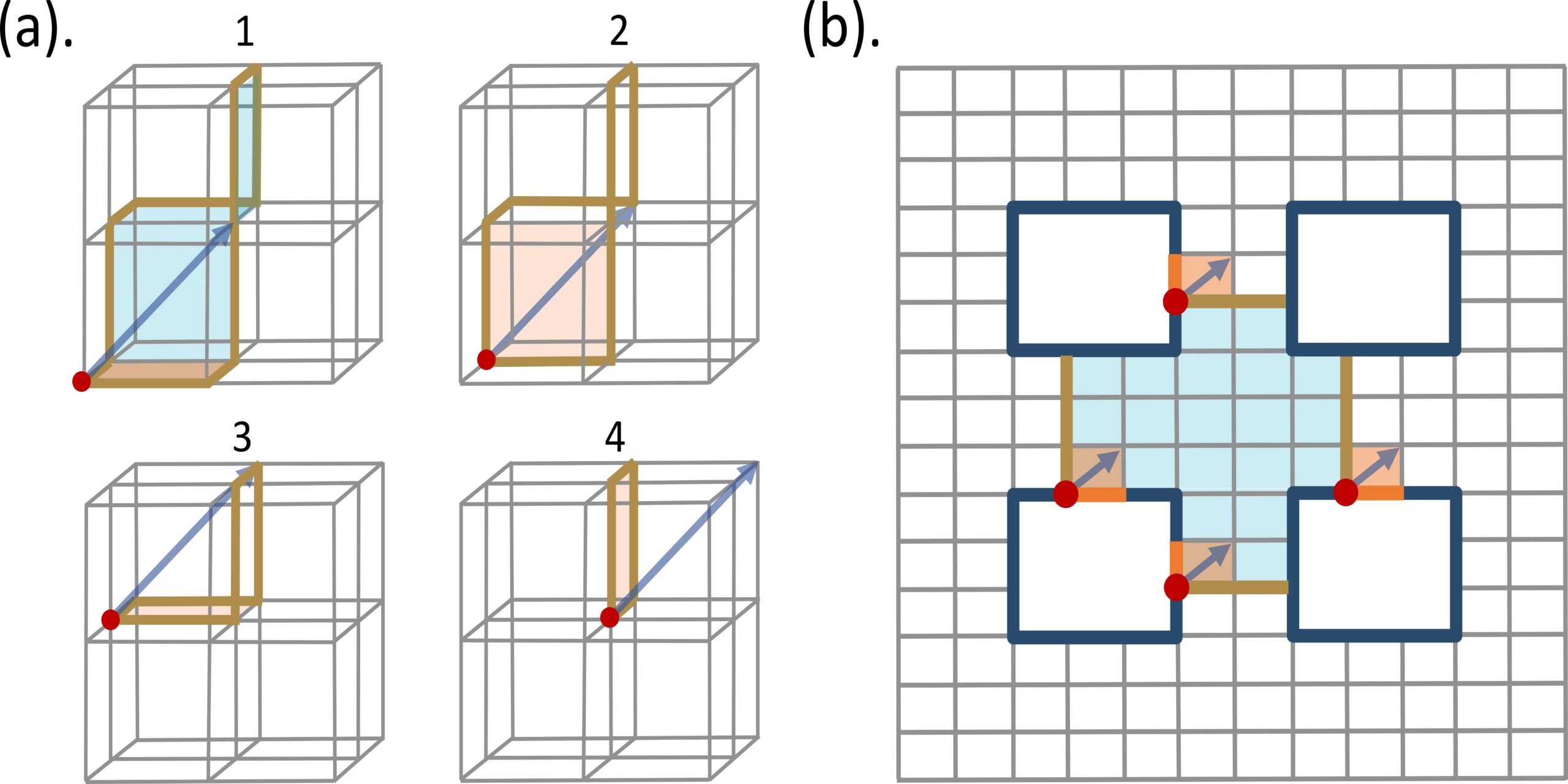
Featured image: Generalizing sweep rule to lattice with holes
Popular summary
► BibTeX data
► References
[1] Guanyu Zhu, Tomas Jochym-O’Connor, and Arpit Dua. “Topological order, quantum codes and quantum computation on fractal geometries” (2021).
https://doi.org/10.1103/PRXQuantum.3.030338
[2] S. B. Bravyi and A. Yu. Kitaev. “Quantum codes on a lattice with boundary” (1998). arXiv:quant-ph/9811052.
arXiv:quant-ph/9811052
[3] Alexei Y. Kitaev. “Fault-tolerant quantum computation by anyons”. Annals of Physics 303, 2–30 (2003).
https://doi.org/10.1016/S0003-4916(02)00018-0
[4] Eric Dennis, Alexei Kitaev, Andrew Landahl, and John Preskill. “Topological quantum memory”. Journal of Mathematical Physics 43, 4452–4505 (2002).
https://doi.org/10.1063/1.1499754
[5] H. Bombin and M. A. Martin-Delgado. “Topological quantum distillation”. Physical Review Letters 97 (2006).
https://doi.org/10.1103/physrevlett.97.180501
[6] Austin G. Fowler, Matteo Mariantoni, John M. Martinis, and Andrew N. Cleland. “Surface codes: Towards practical large-scale quantum computation”. Physical Review A 86 (2012).
https://doi.org/10.1103/physreva.86.032324
[7] Sergey Bravyi and Robert König. “Classification of topologically protected gates for local stabilizer codes”. Physical Review Letters 110 (2013).
https://doi.org/10.1103/physrevlett.110.170503
[8] Tomas Jochym-O’Connor, Aleksander Kubica, and Theodore J. Yoder. “Disjointness of stabilizer codes and limitations on fault-tolerant logical gates”. Phys. Rev. X 8, 021047 (2018).
https://doi.org/10.1103/PhysRevX.8.021047
[9] Sergey Bravyi and Alexei Kitaev. “Universal quantum computation with ideal clifford gates and noisy ancillas”. Phys. Rev. A 71, 022316 (2005).
https://doi.org/10.1103/PhysRevA.71.022316
[10] Daniel Litinski. “A game of surface codes: Large-scale quantum computing with lattice surgery”. Quantum 3, 128 (2019).
https://doi.org/10.22331/q-2019-03-05-128
[11] Michael A. Levin and Xiao-Gang Wen. “String-net condensation: A physical mechanism for topological phases”. Phys. Rev. B 71, 045110 (2005).
https://doi.org/10.1103/PhysRevB.71.045110
[12] Robert Koenig, Greg Kuperberg, and Ben W. Reichardt. “Quantum computation with turaev–viro codes”. Annals of Physics 325, 2707–2749 (2010).
https://doi.org/10.1016/j.aop.2010.08.001
[13] Alexis Schotte, Guanyu Zhu, Lander Burgelman, and Frank Verstraete. “Quantum error correction thresholds for the universal fibonacci turaev-viro code”. Phys. Rev. X 12, 021012 (2022).
https://doi.org/10.1103/PhysRevX.12.021012
[14] Guanyu Zhu, Ali Lavasani, and Maissam Barkeshli. “Universal logical gates on topologically encoded qubits via constant-depth unitary circuits”. Phys. Rev. Lett. 125, 050502 (2020).
https://doi.org/10.1103/PhysRevLett.125.050502
[15] Ali Lavasani, Guanyu Zhu, and Maissam Barkeshli. “Universal logical gates with constant overhead: instantaneous dehn twists for hyperbolic quantum codes”. Quantum 3, 180 (2019).
https://doi.org/10.22331/q-2019-08-26-180
[16] Guanyu Zhu, Ali Lavasani, and Maissam Barkeshli. “Instantaneous braids and dehn twists in topologically ordered states”. Phys. Rev. B 102, 075105 (2020).
https://doi.org/10.1103/PhysRevB.102.075105
[17] Guanyu Zhu, Mohammad Hafezi, and Maissam Barkeshli. “Quantum origami: Transversal gates for quantum computation and measurement of topological order”. Phys. Rev. Research 2, 013285 (2020).
https://doi.org/10.1103/PhysRevResearch.2.013285
[18] Aleksander Kubica, Beni Yoshida, and Fernando Pastawski. “Unfolding the color code”. New Journal of Physics 17, 083026 (2015).
https://doi.org/10.1088/1367-2630/17/8/083026
[19] Michael Vasmer and Dan E. Browne. “Three-dimensional surface codes: Transversal gates and fault-tolerant architectures”. Physical Review A 100, 012312 (2019).
https://doi.org/10.1103/PhysRevA.100.012312
[20] Héctor Bombín. “Gauge color codes: optimal transversal gates and gauge fixing in topological stabilizer codes”. New J. Phys. 17, 083002 (2015).
https://doi.org/10.1088/1367-2630/17/8/083002
[21] Héctor Bombín. “Single-shot fault-tolerant quantum error correction”. Phys. Rev. X 5, 031043 (2015).
https://doi.org/10.1103/PhysRevX.5.031043
[22] Aleksander Kubica and John Preskill. “Cellular-automaton decoders with provable thresholds for topological codes”. Phys. Rev. Lett. 123, 020501 (2019).
https://doi.org/10.1103/PhysRevLett.123.020501
[23] Michael Vasmer, Dan E. Browne, and Aleksander Kubica. “Cellular automaton decoders for topological quantum codes with noisy measurements and beyond” (2020).
https://doi.org/10.1038/s41598-021-81138-2
[24] Benjamin J. Brown, Daniel Loss, Jiannis K. Pachos, Chris N. Self, and James R. Wootton. “Quantum memories at finite temperature”. Rev. Mod. Phys. 88, 045005 (2016).
https://doi.org/10.1103/RevModPhys.88.045005
[25] Austin G. Fowler, Adam C. Whiteside, and Lloyd C. L. Hollenberg. “Towards practical classical processing for the surface code”. Physical Review Letters 108 (2012).
https://doi.org/10.1103/physrevlett.108.180501
[26] Fernando Pastawski, Lucas Clemente, and Juan Ignacio Cirac. “Quantum memories based on engineered dissipation”. Phys. Rev. A 83, 012304 (2011).
https://doi.org/10.1103/PhysRevA.83.012304
[27] Justin L. Mallek, Donna-Ruth W. Yost, Danna Rosenberg, Jonilyn L. Yoder, Gregory Calusine, Matt Cook, Rabindra Das, Alexandra Day, Evan Golden, David K. Kim, Jeffery Knecht, Bethany M. Niedzielski, Mollie Schwartz, Arjan Sevi, Corey Stull, Wayne Woods, Andrew J. Kerman, and William D. Oliver. “Fabrication of superconducting through-silicon vias” (2021). arXiv:2103.08536.
arXiv:2103.08536
[28] D. Rosenberg, D. Kim, R. Das, D. Yost, S. Gustavsson, D. Hover, P. Krantz, A. Melville, L. Racz, G. O. Samach, and et al. “3d integrated superconducting qubits”. npj Quantum Information 3 (2017).
https://doi.org/10.1038/s41534-017-0044-0
[29] Jerry Chow, Oliver Dial, and Jay Gambetta. “$text{IBM Quantum}$ breaks the 100‑qubit processor barrier” (2021).
[30] Sara Bartolucci, Patrick Birchall, Hector Bombin, Hugo Cable, Chris Dawson, Mercedes Gimeno-Segovia, Eric Johnston, Konrad Kieling, Naomi Nickerson, Mihir Pant, Fernando Pastawski, Terry Rudolph, and Chris Sparrow. “Fusion-based quantum computation” (2021). arXiv:2101.09310.
arXiv:2101.09310
[31] Héctor Bombín, Isaac H. Kim, Daniel Litinski, Naomi Nickerson, Mihir Pant, Fernando Pastawski, Sam Roberts, and Terry Rudolph. “Interleaving: Modular architectures for fault-tolerant photonic quantum computing” (2021). arXiv:2103.08612.
arXiv:2103.08612
[32] Sergey Bravyi and Jeongwan Haah. “Quantum self-correction in the 3d cubic code model”. Phys. Rev. Lett. 111, 200501 (2013).
https://doi.org/10.1103/PhysRevLett.111.200501
[33] Chenyang Wang, Jim Harrington, and John Preskill. “Confinement-higgs transition in a disordered gauge theory and the accuracy threshold for quantum memory”. Annals of Physics 303, 31–58 (2003).
https://doi.org/10.1016/s0003-4916(02)00019-2
[34] Helmut G. Katzgraber, H. Bombin, and M. A. Martin-Delgado. “Error threshold for color codes and random three-body ising models”. Phys. Rev. Lett. 103, 090501 (2009).
https://doi.org/10.1103/PhysRevLett.103.090501
[35] Jack Edmonds. “Paths, trees, and flowers”. Canadian Journal of Mathematics 17, 449–467 (1965).
https://doi.org/10.4153/CJM-1965-045-4
[36] Hector Bombin. “2d quantum computation with 3d topological codes” (2018). arXiv:1810.09571.
arXiv:1810.09571
[37] Benjamin J. Brown. “A fault-tolerant non-clifford gate for the surface code in two dimensions”. Science Advances 6 (2020).
https://doi.org/10.1126/sciadv.aay4929
[38] Aleksander Kubica and Michael Vasmer. “Single-shot quantum error correction with the three-dimensional subsystem toric code” (2021).
https://doi.org/10.1038/s41467-022-33923-4
[39] H. Bombin. “Gauge color codes: Optimal transversal gates and gauge fixing in topological stabilizer codes” (2015). arXiv:1311.0879.
arXiv:1311.0879
[40] Michael John George Vasmer. “Fault-tolerant quantum computing with three-dimensional surface codes”. PhD thesis. UCL (University College London). (2019).
Cited by
[1] Neereja Sundaresan, Theodore J. Yoder, Youngseok Kim, Muyuan Li, Edward H. Chen, Grace Harper, Ted Thorbeck, Andrew W. Cross, Antonio D. Córcoles, and Maika Takita, “Demonstrating multi-round subsystem quantum error correction using matching and maximum likelihood decoders”, Nature Communications 14, 2852 (2023).
[2] Arpit Dua, Nathanan Tantivasadakarn, Joseph Sullivan, and Tyler D. Ellison, “Engineering Floquet codes by rewinding”, arXiv:2307.13668, (2023).
[3] Eric Huang, Arthur Pesah, Christopher T. Chubb, Michael Vasmer, and Arpit Dua, “Tailoring three-dimensional topological codes for biased noise”, arXiv:2211.02116, (2022).
The above citations are from SAO/NASA ADS (last updated successfully 2023-09-27 01:52:57). The list may be incomplete as not all publishers provide suitable and complete citation data.
On Crossref’s cited-by service no data on citing works was found (last attempt 2023-09-27 01:52:56).
This Paper is published in Quantum under the Creative Commons Attribution 4.0 International (CC BY 4.0) license. Copyright remains with the original copyright holders such as the authors or their institutions.
- SEO Powered Content & PR Distribution. Get Amplified Today.
- PlatoData.Network Vertical Generative Ai. Empower Yourself. Access Here.
- PlatoAiStream. Web3 Intelligence. Knowledge Amplified. Access Here.
- PlatoESG. Carbon, CleanTech, Energy, Environment, Solar, Waste Management. Access Here.
- PlatoHealth. Biotech and Clinical Trials Intelligence. Access Here.
- Source: https://quantum-journal.org/papers/q-2023-09-26-1122/
- :has
- :is
- :not
- ][p
- 001
- 01
- 08
- 1
- 10
- 100
- 11
- 12
- 125
- 13
- 14
- 15%
- 16
- 17
- 180
- 19
- 1998
- 20
- 2005
- 2006
- 2011
- 2012
- 2013
- 2015
- 2016
- 2017
- 2018
- 2019
- 2020
- 2021
- 2022
- 2023
- 22
- 23
- 24
- 25
- 26%
- 27
- 28
- 29
- 30
- 31
- 32
- 33
- 36
- 39
- 3d
- 40
- 7
- 8
- 9
- 97
- a
- above
- ABSTRACT
- access
- accuracy
- Adam
- adapt
- adaptation
- advances
- affiliations
- AL
- All
- and
- Andrew
- approaches
- ARE
- arpit
- Arthur
- AS
- At
- attempt
- austin
- author
- authors
- barrier
- based
- BE
- been
- ben
- Benjamin
- Beyond
- biased
- Block
- both
- Bound
- boundaries
- boundary
- Break
- breaks
- brown
- by
- CA
- cable
- california
- CAN
- Canadian
- Capacity
- Center
- challenge
- chen
- chow
- Chris
- Christopher
- Chubb
- class
- code
- codes
- College
- color
- comment
- Commons
- Communications
- complete
- computation
- computing
- constant
- copyright
- Corresponding
- could
- critical
- Cross
- crucial
- Daniel
- data
- David
- day
- Decoding
- demonstrating
- designing
- desired
- developed
- Dimension
- dimensions
- discuss
- document
- due
- e
- E&T
- Edward
- Ellison
- Engineering
- error
- Errors
- Even
- exist
- Fibonacci
- First
- For
- found
- frank
- from
- FSC
- game
- Gates
- gauge
- George
- Golden
- grace
- harvard
- Have
- heights
- High
- higher
- holders
- Holes
- hover
- HTTPS
- huang
- hugo
- IBM
- ideal
- image
- in
- information
- Institute
- institutions
- integrated
- interactions
- interesting
- International
- investigate
- ITS
- jack
- james
- JavaScript
- Jim
- John
- journal
- jpg
- juan
- Justin
- Kim
- König
- large-scale
- Last
- Leave
- Length
- Li
- License
- likelihood
- limitations
- List
- local
- logical
- London
- loss
- lower
- maintains
- matching
- mathematical
- mathematics
- Matter
- max-width
- maximum
- May..
- measurement
- measurements
- mechanism
- Memories
- Memory
- Michael
- model
- models
- Modifications
- modular
- Month
- Nature
- New
- no
- Noise
- NY
- of
- on
- only
- open
- optimal
- or
- order
- original
- our
- Overcome
- pages
- Paper
- particular
- past
- patrick
- performance
- phd
- physical
- Physics
- plato
- Plato Data Intelligence
- PlatoData
- Point
- possible
- Practical
- presence
- present
- processing
- Processor
- properties
- protected
- protocols
- provable
- provably
- Prove
- provide
- published
- publisher
- publishers
- Quantum
- quantum computing
- quantum error correction
- quantum information
- qubits
- R
- random
- reduce
- references
- regular
- remains
- report
- research
- review
- ROBERT
- Rule
- s
- Sam
- San
- San Jose
- scales
- scheme
- Science
- SELF
- significantly
- sparrow
- States
- Still
- strategies
- studied
- Study
- style
- Successfully
- such
- suitable
- Sullivan
- superconducting
- Surface
- Surgery
- sustainable
- Sweep
- Technology
- Ted
- that
- The
- their
- theory
- There.
- These
- thesis
- this
- thought
- three-dimensional
- threshold
- Title
- to
- topological quantum
- towards
- transition
- Trees
- twists
- two
- tyler
- UCL
- under
- Universal
- university
- updated
- URL
- using
- via
- volume
- W
- want
- was
- Watson
- we
- were
- when
- which
- widely
- william
- with
- Woods
- Work
- works
- X
- year
- zephyrnet







